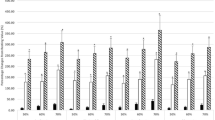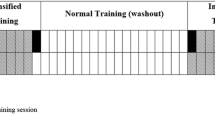Abstract
The purpose of this study was to examine the impact of heavy-resistance exercise-induced elevations of plasma cortisol on circulating leukocyte counts. Nine healthy, recreationally weight-trained men volunteered for this investigation. Two exercise protocols were employed. Protocol 1 (P-1) consisted of eight sets of ten-repetition maximum leg-press exercise with 1-min rest periods between sets. Protocol 2 (P-2) was identical except for 3-min rest periods. A non-exercise protocol was used as a control treatment (C). Venous blood samples, heart rates and ratings of perceived exertion were obtained pre-, mid- and 5 min post-exercise. In order to examine the maximal influence of cortisol on leukocyte counts, we placed the subject's highest magnitude of cortisol change in response to one of the heavy-resistance exercise protocols in what we designated as the response protocol (R) and the other value was placed into what was designated as the non-response protocol (NR) for analysis. Significant increases in cortisol occurred from pre- to post-exercise for P-1 [mean (SD) 241.4 (25.0) to 302.0 (60.0) nmol · 1−1] and in the R conditions pre- to mid- and pre- to post-exercise [218.0(0.0) to 302.4(37.1) to 326.8 (51.9) nmol · 1−1]. No significant changes in cortisol occurred for P-2, NR or the control conditions. Significant increases in total leukocyte counts occurred from pre- to mid- and pre- to post-exercise both for R [5.6 (0.4) to 7.4 (0.3) to 7.3 (0.3) cells · 109 · 1−1] and NR [5.7 (0.3) to 6.9 (0.4) to 7.1 (0.4) cells · 109 · 1−1]. No significant changes in differential leukocyte counts occurred. In addition, no significant correlations between cortisol and total or differential leukocyte counts were observed. These data indicate that acute increases in total leukocytes along with no changes in differential leukocyte counts can occur in response to heavy-resistance exercise that does not significantly elevate plasma cortisol concentrations.
Similar content being viewed by others
References
Cupps TR, Fauci AS (1982) Corticosteroid-mediated immunoregulation in man. Immunol Rev 65:133–155
Dill DB, Costill DL (1974) Calculation of percentage changes in volume of blood, plasma and red cells in dehydration. J Appl Physiol 37:247–248
Dorner H, Heinold D, Hilmer W (1987) Exercise-induced leucocytosis-its dependence on physical capability. Int J Sports Med 8: 152 [Abstr]
Fauci AS, Dale DC (1974) The effect of in vivo hydrocortisone on subpopulations of human lymphocytes. J Clin Invest 53:240–246
Fauci AS, Murakami T, Brandon DD, Loriaux DL, Lipsett MB (1980) Mechanisms of corticosteroid action on lymphocyte subpopulations. Cell Immunol 49:43–50
Ferry A, Picard F, Duvallet A, Weill B, Rieu M (1990) Changes in blood leukocyte populations induced by acute maximal and chronic submaximal exercise. Eur J Appl Physiol 59:435–442
Gabriel H, Urhausen A, Kinderman W (1992) Mobilization of circulating leucocyte and lymphocyte subpopulations during and after short, anaerobic exercise. Eur J Appl Physiol 65:164–170
Gray AB, Smart YC, Telford RD, Weidemann MJ, Roberts TK (1992) Anaerobic exercise causes transient changes in leukocyte subsets and IL-2R expression. Med Sci Sports Exerc 24:1332–1338
Hansen JB, Wilsgard L, Ostierud B (1991) Biphasic changes in leukocytes induced by strenuous exercise. Eur J Appl Physiol 62:157–161
Kraemer WJ, Noble BJ, Clark MJ, Culver BW (1987) Physiologic responses to heavy-resistance exercise with very short rest periods. Int J Sports Med 8:247–252
Kraemer WJ, Dziados JE, Marchitelli LJ, Gordon SE, Harman EA, Mello R, Fleck S, Frykman PN, Tripletti NT (1993) Effects of different heavy-resistance exercise protocols on plasma β-endorphin concentrations. J Appl Physiol 74:450–459
Kraemer WJ, Gordon SE, Fleck SJ, Marchitelli LJ, Mello R, Dziados JE, Friedl K, Harman E (1991) Endogenous anabolic hormonal and growth factor responses to heavy resistance exercise in males and females. Int J Sports Med 12:228–235
McCarthy DA, Dale MM (1988) The leucocytosis of exercise:a review and model. Sports Med 6:333–363
Ndon JA, Snyder AC, Foster C, Wehrenberg WB (1992) Effects of chronic intense exercise training on the leukocyte response to acute exercise. Int J Sports Med 13:176–182
Nieman DC, Henson DA, Johnson R, Lebeck L, Davis JM, Nehlsen Cannarella SL (1992) Effects of brief, heavy exertion on circulating lymphocyte subpopulations and proliferative response. Med Sci Sports Exerc 24:1339–1345
Nieman DC, Henson DA, Herring Sampson, Suttles C, Suttles J, Conley M, Stone MH (1994) Natural killer cell cytotoxic in weight trainers and sedentary controls. J Strength Cond Res 8:251–254
Noble BJ, Borg GAV, Jacobs I, Ceci R, Kaiser P (1983) A categoryratio perceived exertion scale: relationship to blood and muscle lactates and heart rate. Med Sci Sport Exerc 15:523–528
Pedersen BK (1991) Influence of physical activity on the cellular immune system: mechanisms of action. Int J Sports Med 12:S23–S29
Sheehan DC, Hrapchak BB (1973) Theory and practice of histotechnology. Mosby, St. Louis, pp 122–125
Shephard RJ, Verde TJ, Thomas SG, Shek P (1991) Physical activity and the immune system. Can J Sport Sci 16:163–185
Weicker H, Werle E (1991) Interaction between hormones and the immune system. Int J Sports Mod 12: S30-S37
Yu DTY, Clements PJ, Pearson CM (1977) Effect of corticosteroids on exercise-induced lymphocytosis. Clin Exp Immunol 28:326–331
Author information
Authors and Affiliations
Rights and permissions
About this article
Cite this article
Kraemer, W.J., Clemson, A., Triplett, N.T. et al. The effects of plasma cortisol elevation on total and differential leukocyte counts in response to heavy-resistance exercise. Europ. J. Appl. Physiol. 73, 93–97 (1996). https://doi.org/10.1007/BF00262815
Accepted:
Issue Date:
DOI: https://doi.org/10.1007/BF00262815




